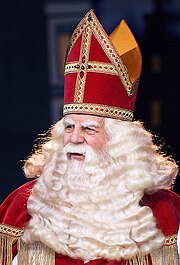Yesterday I showed you four of our five most popular traditions, based on the top 100 of most the important Dutch traditions. I still owe you the number one from that list.

Our number one tradition is Sinterklaas. Sinterklaas is a nickname for St. Nicholas, and we celebrate his feast every year on St. Nicholas eve (5 December).
Sinterklaas arrives about three weeks before his birthday (6 December), on a steamship, with his assistants, the Zwarte Pieten (sing. Zwarte Piet, Black Pete), his grey horse, and plenty of presents for all Dutch children. Each year, he arrives in a different town. This year, the arrival was in Almere, on 15 November. This arrival is broadcast live on Dutch television (it has been broadcast every year for decades). In the three weeks he is in The Netherlands, he visits every school, every shopping mall, and many homes and companies. If you are in The Netherlands this week, there is a good chance you will meet him - just visit the nearest mall. He will be sitting on a central spot, while his Zwarte Pieten are walking around the mall, handing out pepernoten (ginger bread cookies) to young children.
Traditionally, on 5 December, children would put a shoe near the chimney. They would then find a present in it on the morning of 6 December, St. Nicholas day. Nowadays, children leave their shoes several times between the arrival of the steamship and St. Nicholas eve. In modern houses or apartments without a chimney they leave their shoes near a small window. The children put a carrot or some sugar cubes in their shoe and a cup of water next to it (for the grey horse), and sing a traditional St. Nicholas song (loudly in case one of the Zwarte Pieten is on the roof, so that he can hear their songs). At night, Sinterklaas will ride over the roofs (on his grey horse), or send one of his Zwarte Pieten, to throw presents through the chimney into the shoes. If the children left something for the horse, or for Sinterklaas (some children make a drawing and put it in their shoes, as a gift for Sinterklaas), a Zwarte Piet comes down the chimney (however small the chimney may be) to collect it.
St. Nicholas eve is now pakjesavond, present eve. If there are small children, the family will get together and sing traditional Sinterklaas songs. After a while, there is a loud knock on the door, the door opens slightly, and the hand of a Zwarte Piet is seen. Zwarte Piet throws a handful of pepernoten into the room. The children first crawl around to collect the pepernoten, and then open the door to see if Zwarte Piet is still there. He never is, but they do find a basket full of presents that he left behind. (For some reason, Zwarte Piet always chooses a time when one of the adults has gone to the toilet, or gone out to get some fresh air. The adult is then disappointed that he missed all the fun...)
If there are no small children in the family, people will give each other gifts, usually anonymously. They will draw names to decide who gives to whom, and then put their gifts in a basket, and everyone will open their gift on St. Nicholas eve.
Gifts are usually accompanied by a short, simple poem about the receiver, often of a teasing nature (at least for adults and older children). The receiver must read this poem aloud before he is allowed to open the present. Also popular are the surprises (pronounced surpreeses): Either ingeniously wrapped gifts or little practical jokes.
According to our tradition, only sweet children get presents, while naughty children get a rod. Many Zwarte Pieten hold a rod, that they use to wave menacingly. Extremely naughty children go into the empty sacks that were used for transporting the presents, and they are taken away by Sinterklaas on his steamship. I've never heard of any children actually receiving a rod, let alone being taken away in sacks, so I assume there are only sweet children in The Netherlands.

Sinterklaas is an ancient tradition. Jan Steen, a famous painter from the Dutch golden age, painted The feast of St. Nicholas around 1665. Let's have a closer look at this painting (click to enlarge). We see the family gathered around the chimney. In the centre we see a happy little girl, she probably just received the doll she is holding. The boy on the left has probably been naughty, his sisters (gleefully) hold his shoe with a rod. But grandma beckons him in the background, maybe she has a little surprise for him hidden behind the bed-curtain. Notice the boy in the background, holding the baby. He is pointing to the chimney and seems to be explaining to his younger siblings how Zwarte Piet came down through it to leave the presents.
If you have Dutch roots, I would like to hear from you. Do you still celebrate Sinterklaas? Do you know something about your ancestors celebrating Sinterklaas? Places with strong Dutch roots often have a Sinterklaas celebration. Is Sinterklaas celebrated in your area? Please leave your stories in the comments below this post.
Further reading:
Labels: Dutch culture, Dutch traditions, Sinterklaas












3 Comments:
Hi Henk,
I enjoy seeing the postcards you post. do you use any specific types of covers or storage materials for your postcards? Any suggestions would be appreciated.
thanks,
Shack - The Ancestry Ace
Hi Henk,
I'm not sure if my comment went through. I enjoy your postcards and wonder if you use any specific types of covers or storage media for your postcard collection. Any suggestions would be appreciated.
thanks,
Shack - The Ancestry Ace
Hi Shack,
I currently use normal envelopes: One card per envelope, and multiple envelopes with related cards in a strong A5 size envelope. The A5 envelopes go into a filing cabinet.
Post a Comment
<< Home